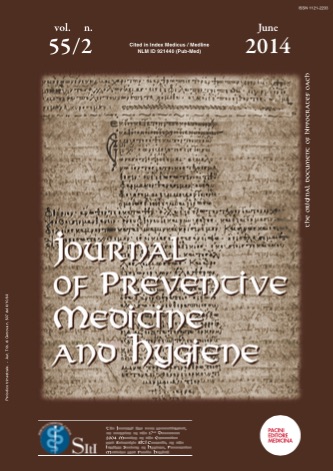Abstract
Introduction. Malaria still constitutes a serious public health problem in Nigeria despite control efforts. The use of Insecticide Treated Net (ITN) has been proven to be an effective preventive modality in the control of malaria but its utilisation has been shown to be low. This study assessed the ownership and utilisa- tion of ITN in Igbo-Ora, a rural community in Ibarapa Central Local Government Area (LGA) of Oyo State, Southwest Nigeria. Methods. A descriptive cross-sectional survey among female caregivers of under-five children and pregnant women was con- ducted using semi-structured interviewer-administered question- naire. Data were analyzed using SPSS version 16. Results. Among 631 respondents that participated, 84.9% were car- egivers of under-five children. Mean age was 27.7 ± 6.3 years with 53.4% between 20-29 age group. Majority, 91.1% had at least pri- mary education, 60.2% were traders and 69.7% were married. Most respondents, 71.8% had at least one type of mosquito nets. Among those that had, 85.4% had window/door net, 25.2% untreated mos- quito net while only 15.5% had ITN. Overall, 11.1% of the respond- ents had ITN among which 78.6% had ever slept under an ITN. Among those that had ever slept under an ITN, slightly less than half, 49.1% slept under an ITN the previous night. Less educated respond- ents were five times more likely to use ITN (95% CI = 1.24-21.28). Conclusions. This study revealed very low ownership and utilisa- tion of ITNs. There is need to improve on the knowledge of com- munity members of the relevance of ownership and utilisation of ITN in malaria prevention.References
Breman JG, Egan A, GT K. The intolerable burden of malaria: a new look at the numbers. Am J Trop Med Hyg. 2001;64(Suppl. iv-vii):1–2.
Prothero RM. Migration and malaria risk. Health Risk Soc. 2001;3:19–38.
Oresanya BO, Hoshen M, Sofola TO. Utilisation of insecticidetreated nets by under-five in Nigeria: Assessing progress towards the Abuja targets. Malar J. 2008;7:145–145.
The Global Malaria Action Plan [Accessed March 2, 2014]; The Roll Back Malaria Partnership. 2008 Available at: http://www.rbm.who.int/gmap/gmap.pdf.
World Health Organization , author. Roll Back Malaria: Global Strategic Plan, 2005-2015. Geneva: 2005. Roll Back Malaria Partnership.
Pettifor A, Tailor E, Nku D, et al. Bed net ownership, use and perceptions among women seeking antenatal care in Kinshasa, Democratic Republic of the Congo (DRC): Opportunities for improved maternal and child health. BMC Public Health. 2008;8:331–331.
Schellenberg JR, Abdulla S, Nathan R, et al. Effect of largescale social marketing of insecticide-treated nets on child survival in rural Tanzania. Lancet. 2001;357:1241–1247.
Binka FN, Indome F, Smith T. Impact of spatial distribution of permethrin-impregnated bed nets on child mortality in rural northern Ghana. Am J Trop Med Hyg. 1998;59:80–85.
Alonso PL, Lindsay SW, Armstrong JRM, et al. The effect of insecticide-treated bed nets on mortality of Gambian children. Lancet. 1991;337:1499–1502.
Abdulla S, Schellenberg JA, Nathan R, et al. Impact on malaria morbidity of a programme supplying insecticides nets in children aged under 2 years in Tanzania: community cross-sectional study. BMJ. 2001;322:270–273.
Minja H, Schellenberg JA, Mukasa O, et al. Introducing insecticide- treated nets in the Kilombero Valley, Tanzania: the relevance of local knowledge and practice for an Information, Education and Communication (IEC) campaign. Trop Med Int Health. 2008;6:614–623.
Wiseman V, Scott A, McElroy B, et al. Determinants of bed net use in the Gambia: Implication for malaria control. Am J Trop Med Hyg. 2007;76:830–836.
UNICEF, WHO , author. African Malaria Report. 2003
Mugisha F, Arinaitwe J. Sleeping arrangements and mosquito net use among under-fives: results from Uganda Demographic and Health Survey. Malar J. 2003;2:40–40.
NetMark Survey on Insecticide-Treated Nets (ITNs) 2000. Nigeria: 2004.
Tyagi P, Roy A, Malhotra MS. Knowledge awareness and practices towards malaria in communities of Rural, semi-rural and bordering areas of east Delhi, India. J Vector Borne Dis. 2005;42:30–35.
Adongo PB, Kirkwood B, Kendall C. How local community knowledge about malaria affects insecticide treated net use in northern Ghana. Trop Med Int Health. 2005;10:366–378.
Adera TD. Beliefs and traditional treatment of malaria in Kishe settlement area, South West Ethiopia. Ethiopian Medical Journal. 2003;41:25–34.
Legesse Y, Tegegn A, Belachew T, et al. Knowledge, Attitude and Practice about Malaria Transmission and Its Preventive Measures among Households in Urban Areas of Assosa Zone, Western Ethiopia. Ethiop J Health Dev. 2007;21:157–165.
Blackburn BG, Eigege A, Gotau H, et al. Successful integration of insecticide-treated bed net distribution with mass drug administration in central Nigeria. Am J Trop Med Hyg. 2006;75:650–655.
Baume CA, Marin MC. Intra-household mosquito net use in Ethiopia, Ghana, Mali, Nigeria, Senegal, and Zambia: are nets being used? who in the household uses them? Am J Trop Med Hyg. 2007;77:963–971.
Yared L, Ayalew T, Tefera BTK. Knowledge, attitude and practice about malaria transmission and its preventive measures among households in urban areas of Assosa Zone, Western Ethiopia. Ethiop J Health Dev. 2007;21(2)
Animut A, Gebre-Michael T, Medhin G, et al. Assessment of distribution, knowledge and utilisation of insecticide treated nets in selected malaria prone areas of Ethiopia. Ethiop J Health Dev. 2008;22(3)


